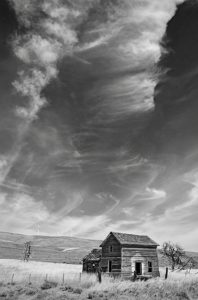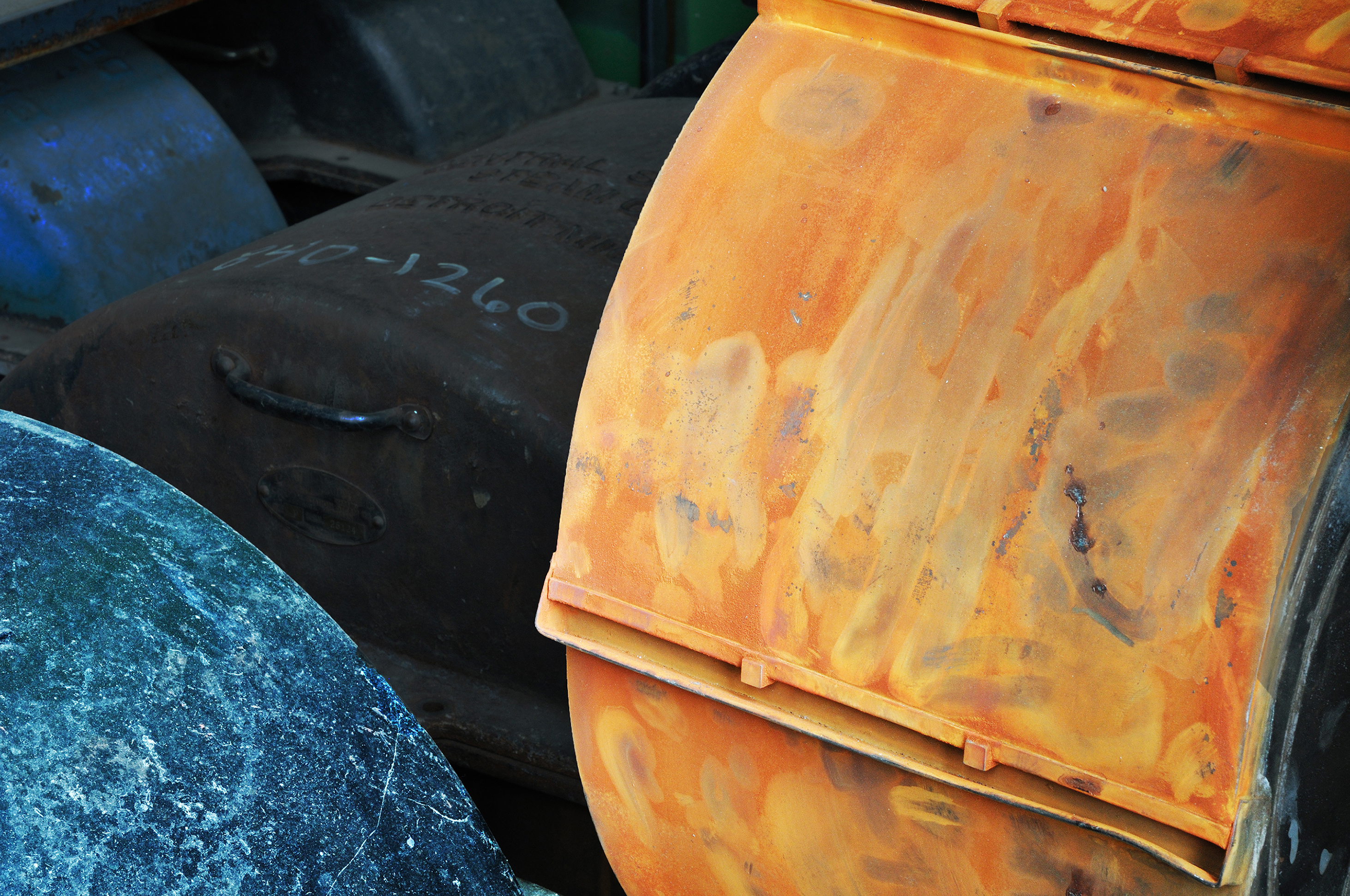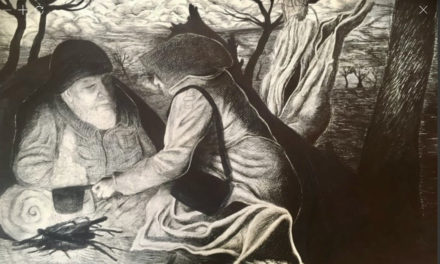(Above: Sumpter Valley Railway at McEwan Station; photograph by Rich Bergeman)
For years, Corvallis photographer Rich Bergeman has traversed the Pacific Northwest, focusing his attention and his cameras on the remains of the great western migration that took place in the 19th century in eastern Oregon and Washington.
The result of this perusal is on display at the White Lotus Gallery in a show titled The Vanishing West, in the form of Bergeman’s photographic prints, both platinum/palladium and pigment inks. He describes this body of work in his artist’s statement:
For the better part of three decades now, I’ve been exploring the back roads east of the Cascades in search of vanishing relics of the Northwest frontier. This is high, wide and dry country, a land of broad horizons and elusive promise, easy to love but not so easy to live on… During the Great Western Migration, as the Native American population gradually gave way to disease, conflict and broken treaties, they were replaced by pioneers hoping to start a new life on their land. Many eventually gave up, leaving a landscape dotted with melancholic relics of their hopes and dreams – schoolhouses crumbling from neglect, homesteads falling back to earth, ghost towns gradually giving up their ghosts…
Bergeman’s photography has come to the attention of The Eugene Scene in the past. In one of his occasional On Photography columns, photographer/writer Paul Carter interviewed Bergeman and offered the following glimpse into the man and his career.
By Paul Carter
Rich Bergeman enjoys a good cigar.
Sometimes, while walking his dog in the evening, he leaves a trail of aromatic smoke through his neighborhood on the northwest side of Corvallis.
So it makes quirky sense that Bergeman also appreciates the value of a well-crafted cigar box.
Over the years, this artist has become adept at many ways to create sumptuous black-and-white photographs, and among his many methods, a few of his best-known pictures have been produced with a box that was made to hold 25 Drew Estate Tabac Especial coffee-infused cigars.
After a bit of experimentation, he settled on the hinged wooden box to form the body of his 5×7-inch pinhole camera. It is as simple as a camera can be. A film holder fits on one side. On the opposite side, a tiny hole with a slide over it is the shutter. The box is most often placed near the ground to bring something very close in the foreground into the camera’s wide view. An old Pentax spot meter helps to determine exposures lasting anywhere from 35 seconds in open sunlight to 20 minutes in overcast light. Kodak Tri-X is Bergeman’s preferred film. By the way, the empty Tabac boxes can be found on Ebay for about six bucks.
The pinhole obsession lasted from 2009 to 2015, Bergeman said during a recent interview in his leafy backyard.
If you attended Photography at Oregon’s recent auction show at the Dot Dotson’s gallery you might have noticed a photograph of a very dead badger lying precisely on the center line of a country road, the stripe on the mammal’s head matching the pavement stripe. It’s the work of that cigar box.
The thick brush-stroke border of this and other pinhole pictures identifies it as a platinum/palladium print.
Having become expert at printing his negatives on gelatin silver paper, Bergeman wanted to create pictures with a different palette. He taught himself the 19th-century method known to produce images with a distinctive look. Platinum prints are also prized for their archival quality, capable of lasting centuries.
This little history museum in Applegate along Oregon Hwy 238 hasn’t been open for some time, but the hand-hewn log cabin itself has long held a place in local history. It was the original Applegate Store, built in the 1870s by local rancher Bill Pernoll, who 15 years earlier fought with the militia in 1850s Indian wars. It was moved to this site in the 1990s to tell the story of the Upper Applegate Valley, a story of gold and blood. When gold was discovered along the Applegate and its tributaries in the early 1850s, prospectors poured in from the played-out mines in Northern California and inevitably clashed with the local band of the Rogues under Chief John; print and narrative by Rich Bergeman
“Silver photography is a violin,” he likes to use as a metaphor for the deep contrast — black blacks and pure whites — reproduced with silver-based printing. “The platinum palladium print is like the cello.”
“The platinum print’s beauty is in the middle,” he explains. But to really see the low-contrast, long middle tones, his prints have to be experienced firsthand. This is not photography done for Instagram. Stand close to a Bergeman print and let your eyes scan back and forth across the frame. Subtleties emerge. The emulsion suffuses the texture of the paper beneath enhancing the tonal gradations. Each print is a one-of-a-kind object depending on how the emulsion was mixed and then brushed onto the paper. Indeed, the choice of paper itself is a variable in the process; some artists insist on using hand-made paper.
The path to his mastery of fine art photography was a twisting one; there was no indication of it early in his life.
Bergeman grew up in northwest Ohio in small towns not far from the shores of Lake Erie, places named Blackberry Corners, Rocky Ridge and Curtice. He was the son of a tavern owner. On his 18th birthday he started tending bar on Sundays for his dad. He might have been headed for a blue collar life. But “lightning good luck” struck, he says.
A high school guidance counselor pushed him to apply to several schools including Bowling Green State University. Much to his surprise he was accepted at Bowling Green and offered a scholarship. He would never tend bar again. He majored in journalism, graduating in 1971, and launched a career in newspapers.
He started out as a general assignment reporter for the daily Newark Advocate in Newark, Ohio. “I was a young smartass,” he jokes, but he worked his way quickly to city editor. It was at the Advocate that Bergeman first noticed the power of photography. “The first photo I recognized as transcending the storytelling role of news photography was one by John Allee,” a photographer at the Advocate. He describes “a stunning vertical shot of an Amish buggy . . . heading away down a long, curving, hilly road.” He still has a copy of the print hanging in his darkroom.
Newspapering is itinerant work, and he moved on to the Courier-Post in Camden, New Jersey in 1973. He was assigned to the consumer affairs beat. It was his dream job, he recalls, yet he gave it up to cope with a failing marriage and a bout of wanderlust.
Along with two friends, Bergeman headed west on a meandering route toward the west coast. They were on the road for six months. Going up the coast from San Diego he started looking for newspaper jobs. He even applied in Eugene. Nothing worked. But there was a job opening in the information office at Linn-Benton Community College. He took it.
At LBCC, Bergeman advanced to leadership in his office, but he admits he was not happy. So, in 1979 he quit the job and started a master’s degree program in interdisciplinary studies at Oregon State University. He returned to Linn-Benton in 1981 to teach journalism and photojournalism. Now it was time for him to get serious about mastering photography. He started with a class in photojournalism, but he was motivated to teach photography as an art form. He soon added art department courses to that end, including a class in the zone system.
As he pushed himself to learn darkroom technique — one step ahead of his students — he became consumed with the deliberative use of large-format cameras. His subject matter of choice became the deserted interiors of abandoned buildings. Light itself, in the ways it crept into deserted rooms, fascinated him. He carried a 4×5-inch camera into old buildings in Albany, Lebanon and Baker City. Photography also became a process of self-discovery. If he made an ethereal image of a doorway, for example, it helped him enter into a meditation on his own path in life.
Abandonment is a robust genre at all levels of photography. In its lowest form (my opinion), glossy coffee table books will take you on urban “ruin porn” tours of decaying buildings from Detroit to Chernobyl. The internet is rife with over-saturated HDR (high dynamic range) color snaps. A casual search will take you from Rust Belt factories to abandoned villages in Italy. In the American West, ghost towns have cult followings.
Bergeman makes no apology for his attraction to the genre. Abandoned buildings are the “crack cocaine of photography,” he quips. He’s definitely hooked. But he elevates his subjects with exquisite technique.
His way of seeing earned him his first solo show at OSU in 1987.
He knew he was headed in the right direction when one of his photographs in a Photozone show in Eugene was praised by another photographer.
The note jotted in a comment book read: “It would take me days to achieve a print like this.” Bergeman didn’t believe it at first. The note was signed: Manuel Alvarez Bravo. Finally, Bergeman accepted this was no joke. It really was the Mexican master. He had been in Eugene. He had visited the gallery.

Goodnoe Hills, Washington; photograph by Rich Bergeman
That fascination for abandonment became a quest that has pushed Bergeman into a series of projects throughout the American West. Anasazi ruins in Four Corners. Lost homesteads of the Fort Rock basin and across the west. The tidewaters of Oregon Coast Range rivers. Platinum/palladium prints from 8×10-inch negatives of old settlements in the Coast Range. Landscapes of the Rogue River Indian Wars. Digital inkjet prints from pictures of Baker County Country.
He has produced ten portfolios, often with a companion self-published book. Along the way, the artist has experimented with infrared photography and hand-worked Polaroid prints shot with the SX-70 camera. He finally learned digital technique, albeit reluctantly. “I did not enthusiastically move into the digital age,” he explains, “but I had to because my students wanted to learn it.”
It’s a considerable body of work, and it has resulted in more than 30 one-man shows. He has shown in just about every public exhibition space in Oregon. The man is driven.
Now in retirement and about to turn 70, Bergeman has no interest in slowing down. He is planning an exploration of a section of the old Coos Bay-to-Roseburg Wagon Road. It’s a scenic path through five Coast Range valleys and passing several forgotten settlements. He says he wants to use infrared method.
And, chances are good there will be cigar smoke wafting around him as he stops to ponder old places and set up his camera.
The Vanishing West: Photographs by Rich Bergeman
When: Through June 12, 2021
Where: White Lotus Gallery, 767 Willamette St., Eugene
Hours: 10 a.m. to 4 p.m. Tuesday through Saturday
Information: 541-345-3276 or online at wlotus.com










